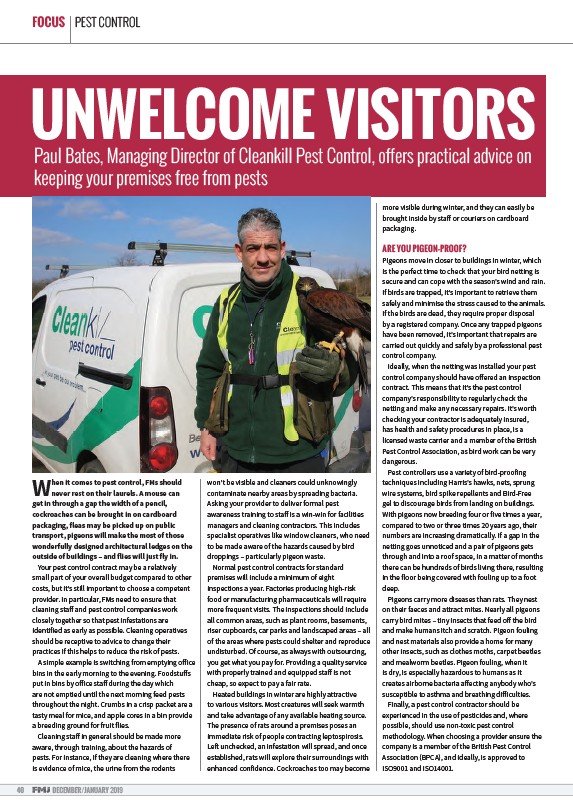
FOCUS PEST CONTROL
UNWELCOME VISITORS Paul Bates, Managing Director of Cleankill Pest Control, off ers practical advice on
keeping your premises free from pests
When it comes to pest control, FMs should
never rest on their laurels. A mouse can
get in through a gap the width of a pencil,
cockroaches can be brought in on cardboard
packaging, fleas may be picked up on public
transport, pigeons will make the most of those
wonderfully designed architectural ledges on the
outside of buildings – and flies will just fly in.
Your pest control contract may be a relatively
small part of your overall budget compared to other
costs, but it’s still important to choose a competent
provider. In particular, FMs need to ensure that
cleaning sta and pest control companies work
closely together so that pest infestations are
identified as early as possible. Cleaning operatives
should be receptive to advice to change their
practices if this helps to reduce the risk of pests.
A simple example is switching from emptying o ice
bins in the early morning to the evening. Foodstu s
put in bins by o ice sta during the day which
are not emptied until the next morning feed pests
throughout the night. Crumbs in a crisp packet are a
tasty meal for mice, and apple cores in a bin provide
a breeding ground for fruit flies.
Cleaning sta in general should be made more
aware, through training, about the hazards of
pests. For instance, if they are cleaning where there
is evidence of mice, the urine from the rodents
40 DECEMBER/JANUARY 2019
won’t be visible and cleaners could unknowingly
contaminate nearby areas by spreading bacteria.
Asking your provider to deliver formal pest
awareness training to sta is a win-win for facilities
managers and cleaning contractors. This includes
specialist operatives like window cleaners, who need
to be made aware of the hazards caused by bird
droppings – particularly pigeon waste.
Normal pest control contracts for standard
premises will include a minimum of eight
inspections a year. Factories producing high-risk
food or manufacturing pharmaceuticals will require
more frequent visits. The inspections should include
all common areas, such as plant rooms, basements,
riser cupboards, car parks and landscaped areas – all
of the areas where pests could shelter and reproduce
undisturbed. Of course, as always with outsourcing,
you get what you pay for. Providing a quality service
with properly trained and equipped sta is not
cheap, so expect to pay a fair rate.
Heated buildings in winter are highly attractive
to various visitors. Most creatures will seek warmth
and take advantage of any available heating source.
The presence of rats around a premises poses an
immediate risk of people contracting leptospirosis.
Le unchecked, an infestation will spread, and once
established, rats will explore their surroundings with
enhanced confidence. Cockroaches too may become
more visible during winter, and they can easily be
brought inside by sta or couriers on cardboard
packaging.
ARE YOU PIGEON-PROOF?
Pigeons move in closer to buildings in winter, which
is the perfect time to check that your bird netting is
secure and can cope with the season’s wind and rain.
If birds are trapped, it’s important to retrieve them
safely and minimise the stress caused to the animals.
If the birds are dead, they require proper disposal
by a registered company. Once any trapped pigeons
have been removed, it’s important that repairs are
carried out quickly and safely by a professional pest
control company.
Ideally, when the netting was installed your pest
control company should have o ered an inspection
contract. This means that it’s the pest control
company’s responsibility to regularly check the
netting and make any necessary repairs. It’s worth
checking your contractor is adequately insured,
has health and safety procedures in place, is a
licensed waste carrier and a member of the British
Pest Control Association, as bird work can be very
dangerous.
Pest controllers use a variety of bird-proofing
techniques including Harris’s hawks, nets, sprung
wire systems, bird spike repellents and Bird-Free
gel to discourage birds from landing on buildings.
With pigeons now breeding four or five times a year,
compared to two or three times 20 years ago, their
numbers are increasing dramatically. If a gap in the
netting goes unnoticed and a pair of pigeons gets
through and into a roof space, in a matter of months
there can be hundreds of birds living there, resulting
in the floor being covered with fouling up to a foot
deep.
Pigeons carry more diseases than rats. They nest
on their faeces and attract mites. Nearly all pigeons
carry bird mites – tiny insects that feed o the bird
and make humans itch and scratch. Pigeon fouling
and nest materials also provide a home for many
other insects, such as clothes moths, carpet beetles
and mealworm beetles. Pigeon fouling, when it
is dry, is especially hazardous to humans as it
creates airborne bacteria a ecting anybody who’s
susceptible to asthma and breathing di iculties.
Finally, a pest control contractor should be
experienced in the use of pesticides and, where
possible, should use non-toxic pest control
methodology. When choosing a provider ensure the
company is a member of the British Pest Control
Association (BPCA), and ideally, is approved to
ISO9001 and ISO14001.